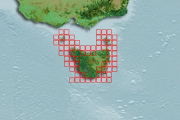2007
Type of resources
Topics
Keywords
Contact for the resource
Provided by
Years
-
Mesozooplankton community composition and structure were examined throughout the D’Entrecasteaux Channel, Huon Estuary and North West Bay, Tasmania, from November 2004 to October 2005, the data represented by this record was collected on the 07/12/2004 The composition of the mesozooplankton community was typical of inshore, temperate marine habitats, with seasonally higher abundance in summer and autumn and lower numbers in winter and spring. Copepods were the largest contributors to total abundance across all seasons and stations, while cladocerans and appendicularians were proportionally abundant in spring and summer. The faecal pellets of these three main groups, along with those of krill and amphipods, also contributed significantly to material recovered from sediment traps. Meroplanktonic larvae of benthic animals showed short-term peaks in abundance and were often absent from the water column for long periods. Spatially, North West Bay and the Channel had a higher representation of typically marine species, including Calanus australis and Labidocera cervi, while truly estuarine species, such as the copepod Gladioferens pectinatus, were more important in the Huon Estuary.
-

Describes the database used for storing Southern Rock Lobster (Jasus edwardsii) biological data collected by observers on commercial boats and dedicated research trips incorporating information on sex, length, weight, damage, reproduction, bycatch, protected species interaction, location, depth, tagging and equipment type.
-
Mesozooplankton community composition and structure were examined throughout the D’Entrecasteaux Channel, Huon Estuary and North West Bay, Tasmania, from November 2004 to October 2005, the data represented by this record was collected on the 21/01/2005. The composition of the mesozooplankton community was typical of inshore, temperate marine habitats, with seasonally higher abundance in summer and autumn and lower numbers in winter and spring. Copepods were the largest contributors to total abundance across all seasons and stations, while cladocerans and appendicularians were proportionally abundant in spring and summer. The faecal pellets of these three main groups, along with those of krill and amphipods, also contributed significantly to material recovered from sediment traps. Meroplanktonic larvae of benthic animals showed short-term peaks in abundance and were often absent from the water column for long periods. Spatially, North West Bay and the Channel had a higher representation of typically marine species, including Calanus australis and Labidocera cervi, while truly estuarine species, such as the copepod Gladioferens pectinatus, were more important in the Huon Estuary.
-

The survey comprises two streams of data, including (1) the availability of different attachment sites and (2) the algal composition of abalone attachment sites ('homesites'). The survey was conducted at three sites at each of three regions on the east coast of Tasmania.
-

This data represents research conducted as part of a PhD project on Striped Trumpeter (Latris lineata). Recorded the prevalence of Kudoa neurophila (a myxozoan parasite formerly known as Pentacapsula neurophila) in relation to age for hatchery reared Striped Trumpeter using histology and PCR testing. Histology and in situ hybridisation techniques were incorporated into the study of the histopathology of the disease caused by this parasite to elucidate its entry point on the fish host and migratory pathway to terminal stage sporulation.
-
The data is quantitative abundance of fish and megafaunal invertebrates and algal % cover derived from transect based counts at a wide range of locations across Temperate Australia. The methods are described in detail in Edgar and Barrett (1997). Primarily the data are derived from transects at 5 m depth and/or 10 m depth at each site surveyed. Methods were initially developed for research on temporal changes following protection in Tasmanian MPAs (Maria Is, Tinderbox, Ninepin Point, Governor Island). The data represented by this record was collected in MPA studies and surveys interstate, and was collected from the Port Lincoln district (SA). In many cases the dataset involved temporal replication (year scale).
-
The data is quantitative abundance of fish and megafaunal invertebrates and algal % cover derived from transect based counts at a wide range of locations across Temperate Australia. The methods are described in detail in Edgar and Barrett (1997). Primarily the data are derived from transects at 5 m depth and/or 10 m depth at each site surveyed. Methods were initially developed for research on temporal changes following protection in Tasmanian MPAs (Maria Is, Tinderbox, Ninepin Point, Governor Island). Further research has collected data in Tasmania, in MPA planning surveys (e.g. St Helens, Waterhouse Region, Low Head, Lillico Beach, Rocky Cape), an oil spill assessment (Low Head), and in studies and surveys in new Tasmania MPAs (Port Davey and the Kent Group). The data represented by this record was collected in MPA planning surveys and for opportunistic surveys such as the Low Head oil spill assessment. In many cases the dataset involved temporal replication (year scale).
-
In fishing trials, the short term survival rates for hook caught flathead (Platycephalus bassensis in Tasmania and P. fuscus in Queensland) were examined to determine critical factors affecting post-release survival. Biological information (size) and hooking location/damage were recorded and fish held for several days in aquaria to assess survival rates. In order to relate hooking location and catch rates for a range of hook types (including circle hooks) structured fishing trials and volunteer fishers (using a diary system) provided information on fish size, hook type and hooking location.
-

Recorded details of visual field ontology (video images recording feeding response and histology of eye and jaw development), behaviour, feeding and jaw development and malformation in larval striped trumpeter (Latris lineata).
-
The southern calamari acoustic telemetry data-set includes information on the tagging and tracking of southern calamari on the east coast of Tasmania. The information includes biological information of tagged squid, deployment information of acoustic receivers and tracking data of squid movement.
 IMAS Metadata Catalogue
IMAS Metadata Catalogue